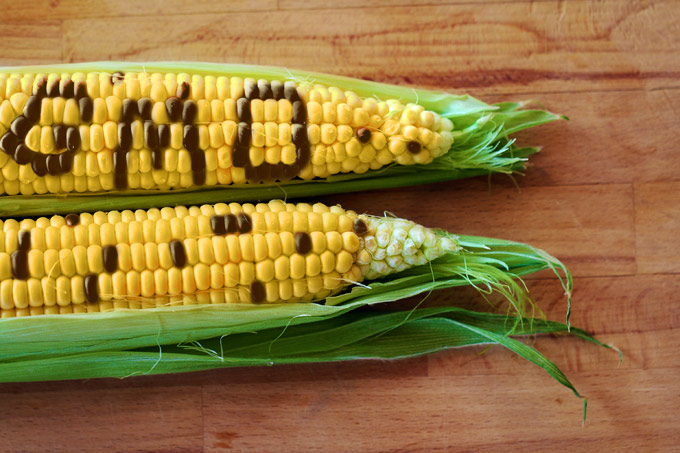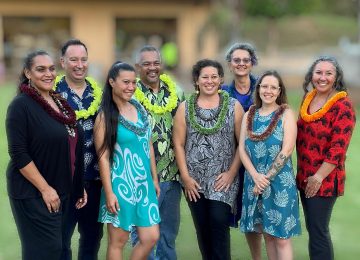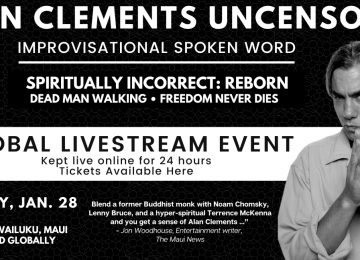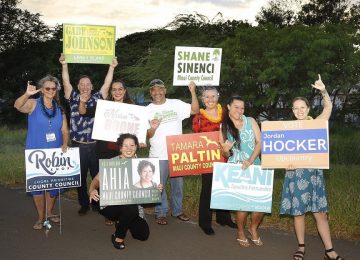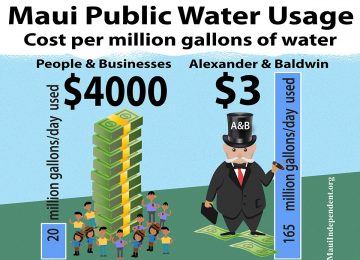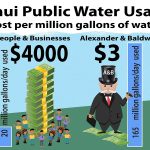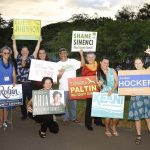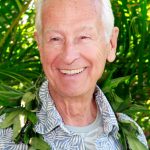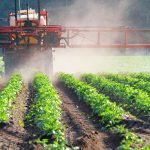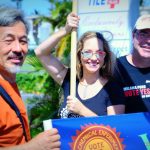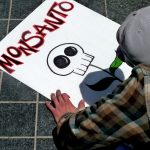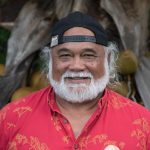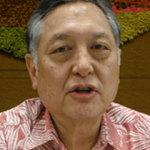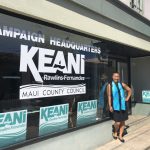In April at the Maui Energy Conference, Rick Volner, the general manager of diversified agriculture for Alexander & Baldwin, gave a presentation on how Maui’s thousands of acres of former sugar cane land could be utilized in the future.
“We have the significant opportunity to alter that landscape,” he said. “Our lands are uniquely positioned to succeed in diversified agriculture.”
Alluding to Gov. David Ige’s pledge to reach the state goal of food and fuel self-sufficiency, he added, “We think the central valley agricultural lands will play a significant role in that.”
Nowhere in that talk did Volner reveal that A&B’s “self-sufficiency” plans included covering Maui’s pesticide-laden central valley with hundreds of acres of Monsanto’s GMO Bt corn.
Community activists and earth protectors, alerted through social media (including this Maui Independent feature) that A&B was growing GMO corn, packed a September 5 Maui County Council hearing on A&B’s ag plans. Most public comment expressed strong opposition to growing GMO crops on the former sugar plantations.
Bt corn has generated controversy in the last few years, as it’s been implicated in the death of monarch butterflies, has contaminated native corn species, is requiring more pesticides as insects develop resistance, and may not be safe for human consumption.
During the meeting, where committee chair Yuki Lei Sugimura tried to suppress public comment on GMO crops, Volner stated his company is not working on or working with any tenants growing GMO food crops. He denied GMO crops were being grown for animal feed. They were only being grown for bio-energy he said.
When queried by Council member Elle Cochran about their GMO crop, Volner stated: “None of the GMO corn is for animal feed.”
This was very surprising news to earth activist Autumn Ness, who a week earlier, had been standing in a harvested field of GMO corn, and was told some of the crop was going to be shipped to Big Island Dairy, which had been growing their own GMO corn.
“We have confirmed that Big Island Dairy has received or will soon receive A&B’s corn,” says Ness, who is on the advisory board of the Hawai’i Center for Food Safety. “They (A&B) are actively looking for buyers.”
Attending an event hosted by Maui Chamber of Commerce and the Maui Farm Bureau, Ness was told by A&B rep Shiloh Stafford Jones that the company had harvested 140 acres of corn – 75% was Bt corn and 25% was conventional non-GMO corn.
“Dick Meyer and I went on their tour and we were standing in the middle of the field,” says Ness, “We watched the combine harvester cut the last few rows of corn and we were told that was their biggest harvest of 140 acres. The next step is to scale up to 500 acres.”
“When HC&S shut there was a collective hope they would continue on an agriculture path. The fear is they are more focused on real estate through land and water banking.”
Mark Sheehan, a leader in the SHAKA movement, concurs. “A&B’s farm plan looks like window dressings,” he says. “A&B is applying to be certified as a real estate investment trust. With 95% of its income coming from property, the company is not an agricultural enterprise. The bottom line is they are land banking and water banking, pretending to do ag while planning to get well compensated when the state agencies give them approvals for malls and subdivisions.”
“While they have declined to meet with the one successful biofuel company from Maui (Pacific Biofuels), they purport to have as many as 60 contenders to lease land, so that’s why they need tons of water.”
Sheehan feels that collective outrage over A&B hogging super-cheap public water while polluting land with GMO crops is having an impact. As The Maui Independent has reported, A&B pays a fraction of 1% of the market value price paid by small Maui farmers for public water, while using more than five times as much public water as everyone else on Maui put together.
“That impact will be more powerful when more people talk back to those Council members who can’t hear the public because they have earplugs supplied by their donors,” he says.
“Just as the Republican mayor and supposedly non-partisan Council votes as a block to promote all corporate/development interests, the ‘aina warriors need to build and maintain a force of protectors who will constantly show up, stand up, speak up to call our the sell out of what are public resources – air, water, soil. Because the pesticides used on crops, whether GMO or not, wind up in our soils, streams, ocean and air. We are having a huge impact and things will never roll back to the good old days of plantation haze.”
For the first time publicly we can report that Maui County Council member Alika Atay met with A&B’s Volner a few weeks before the contentious County meeting to present an extraordinary, innovative proposal that could potentially completely revolutionize agriculture on Maui.
Atay shared a vision based on the principles of permaculture and Native wisdom where 400-foot-wide food forests are divided with 400 foot wide open food crops, working down the mountain. This would include diversified trees, permanent trees, ulu, coconuts etc.
Atay suggested a technique of water utilization using the lay of the land. Referring to the hundreds of miles of roads that are adjacent to farmable lands he noted that 85% of rain catchment is possible with paving improvement of these roads.
“The blacktop can provide the rain to be aimed at the swale (low tract of land) and fill up the punawai (fresh water),” he said. “Rain catchment is anywhere from 20” to 90,” so water from East Maui is not needed as much. When it rains plenty you can pump it into the ditch.
“We can plant forests above and irrigate the fields below. You could literally make microbial spray solutions and spray from a truck along the roadside. Trucks can spray about 20 feet, imagine that for hundreds of miles.”
Atay told the A&B representatives that the greatest goal in life is to become a great ancestor. He told them that your predecessors of A&B have done a poor job. “You have the opportunity to become a great ancestor and to make great decisions for Maui County. You folks have opportunity.”
Just in that arena of food production alone, he said A&B has huge potential. “You will create jobs. You guys get the chance to do great things.”
“We cannot put all our eggs in one basket with tourism,” he emphasized. “As disasters occur the mentality is no-travel. What happens to our economy then? It’s dangerous to be solely dependent in one economy.”
“We need to be strong in diversified industries,” Atay concluded. “It’s a paradigm shift, it’s an entrepreneurial shift to empower. I call it an aloha paradigm shift with collaborative cooperatives.”
Maui’s grassroots organizer Mark Sheehan questions whether A&B will be willing to listen to Atay’s innovative ideas for Maui’s agricultural future. “A&B has ignored input from local farmers and environmental groups for decades,” Sheehan says. “They have neither the knowledge to do better nor even an interest to do the right thing.
“With a climate catastrophe a week hitting somewhere, Maui needs to take control of its resources to assure food security for the future. We can not waste a day as so much needs to be done to: decontaminate the land, assess best soils, regenerate the soils with proper mycorrhizae and minerals to allow farmers to grow nutrient dense food for local markets. UH Maui College has been training a new generation of farmers, the Hawaii Farmers Union United has coordinated a network of farms, farmers and apprentices to extend that education. We should soon have a farm plan along with a tenet farmer lease-to-own arrangement to allow farm families to live where they are growing.”
“Nutrient recycling centers and food hubs need to be formed along with marketing channels. A Malama Wai plan should follow to outline the best use of the public trust waters. Such a plan will involve how to restore the EMI system, allowing greater allocation of water for East Maui stream dwellers and upcountry farmers.”
Autumn Ness too wonders why A&B is not focusing on growing food. “There’s a state wide goal to produce more food,” she says. “And there are plenty of crops like hemp or sunflowers, crops that are really hardy and don’t require a lot of labor. I can’t figure out why they would put their whole model in GMO corn. It doesn’t make any sense.”


